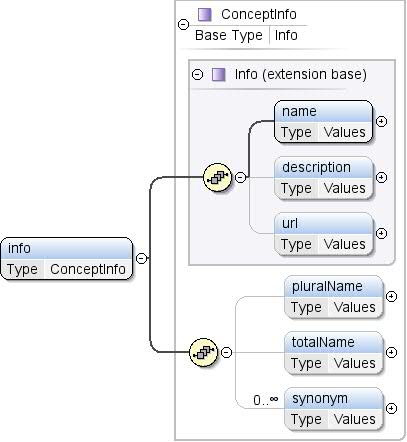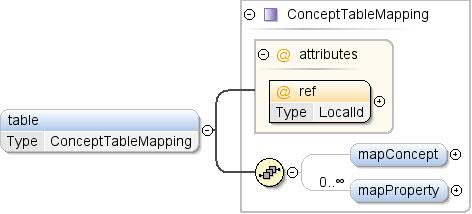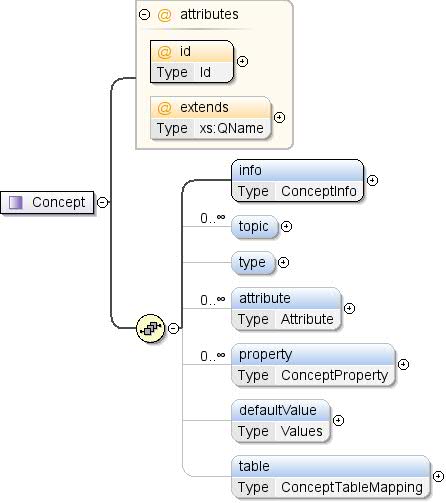Componente: Concetto
Mantieni tutto organizzato con le raccolte
Salva e classifica i contenuti in base alle tue preferenze.
Elemento: concetto / informazioni
| Spazio dei nomi |
http://schemas.google.com/dspl/2010 |
| Annotazioni |
Informazioni testuali, come il nome e la descrizione del
concetto. |
| Diagramma |
 |
| Tipo |
ConceptInfo |
| Gerarchia dei tipi |
|
| Proprietà |
|
| Modello |
name , description{0,1} , url{0,1} , pluralName{0,1} , totalName{0,1} , sinonimo* |
| Bambini |
description, name, pluralName,
sinonimo, totalName, url |
| Istanza |
<info>
<name>{1,1}</name>
<description>{0,1}</description>
<url>{0,1}</url>
</info>
|
| Origine |
<xs:element name="info" type="ConceptInfo">
<xs:annotation>
<xs:documentation>Textual information, such as the name and description of
the concept.</xs:documentation>
</xs:annotation>
</xs:element>
|
Elemento: concetto / argomento
| Spazio dei nomi |
http://schemas.google.com/dspl/2010 |
| Annotazioni |
Un argomento a cui è associato il concetto. |
| Diagramma |
 |
| Proprietà |
| contenuti: |
complesso |
| minOccurs: |
0 |
| maxOccurs: |
illimitati |
|
| Attributi |
| QName |
Tipo |
Risolto |
Predefinito |
Usa |
Annotazione |
| rif |
xs:QName |
|
|
facoltativo |
L'identificatore univoco dell'argomento è questo concetto
associati. L'argomento a cui viene fatto riferimento può essere definito nello stesso
o esternamente, ad esempio in un altro set di dati. Un riferimento a un
l'argomento esterno deve essere nel formato
"prefix:other_topic_id", dove "prefisso" è la
utilizzato per lo spazio dei nomi del set di dati esterno (vedi XML
spazi dei nomi). |
|
| Origine |
<xs:element name="topic" minOccurs="0" maxOccurs="unbounded">
<xs:annotation>
<xs:documentation>A topic the concept is associated with.</xs:documentation>
</xs:annotation>
<xs:complexType>
<xs:attribute name="ref" type="xs:QName">
<xs:annotation>
<xs:documentation>The unique identifier of the topic this concept is
associated with.
The referenced topic may be defined in the same
dataset or externally, i.e., in another dataset. A
reference to an external topic must be of the form
"prefix:other_topic_id", where "prefix" is the prefix
used for the namespace of the external dataset (see
XML namespaces).</xs:documentation>
</xs:annotation>
</xs:attribute>
</xs:complexType>
</xs:element>
|
Elemento: Concetto / tipo
| Spazio dei nomi |
http://schemas.google.com/dspl/2010 |
| Annotazioni |
Il tipo di dati del concetto. Un concetto deve fornire un tipo
dichiarazione o estendere un altro concetto. Nel caso in cui
estendendo un concetto, può anche fornire una dichiarazione di tipo. Il tipo di
il concetto esteso deve essere meno restrittivo del tipo
concetto che la estende. "Meno restrittivo di" (LRT) è una
ordine parziale definito come segue: stringa LRT float float LRT intero
stringa LRT data stringa LRT booleano |
| Diagramma |
 |
| Proprietà |
| contenuti: |
complesso |
| minOccurs: |
0 |
|
| Attributi |
| QName |
Tipo |
Risolto |
Predefinito |
Usa |
Annotazione |
| rif |
DataType |
|
|
di provisioning. |
|
|
| Origine |
<xs:element name="type" minOccurs="0">
<xs:annotation>
<xs:documentation>The data type of the concept. A concept must provide a type declaration or extend
another concept. In the case where it's extending a concept, it may also
provide a type declaration. The type of the extended concept must be less restrictive
than the type of the concept extending it.
"Less restrictive than" (LRT) is a partial order defined as follows:
string LRT float
float LRT integer
string LRT date
string LRT boolean</xs:documentation>
</xs:annotation>
<xs:complexType>
<xs:attribute name="ref" type="DataType" use="required"/>
</xs:complexType>
</xs:element>
|
Elemento: concetto / attributo
| Spazio dei nomi |
http://schemas.google.com/dspl/2010 |
| Annotazioni |
Un attributo del concetto. Gli attributi rappresentano
informazioni sul concetto (ad es. Il PIL è una percentuale). |
| Diagramma |
 |
| Tipo |
Attributo |
| Proprietà |
| contenuti: |
complesso |
| minOccurs: |
0 |
| maxOccurs: |
illimitati |
|
| Modello |
info{0,1} , tipo{0,1} , (valore*
| conceptValue{0,1}) |
| Bambini |
conceptValue, informazioni, tipo,
valore |
| Istanza |
<attribute concept="" id="">
<info>{0,1}</info>
<type format="" ref="">{0,1}</type>
</attribute>
|
| Attributi |
| QName |
Tipo |
Risolto |
Predefinito |
Usa |
Annotazione |
| concetto |
xs:QName |
|
|
facoltativo |
Un riferimento a un concetto che corrisponde ai valori
dell'attributo. Se l'attributo specifica un tipo, allora il tipo
deve corrispondere al tipo del concetto a cui viene fatto riferimento. Un riferimento a un
il concetto esterno deve avere il formato
"prefix:other_concept_id", dove "prefisso" sono
il prefisso utilizzato per lo spazio dei nomi del set di dati esterno (vedi XML
spazi dei nomi). |
| id |
LocalId |
|
|
facoltativo |
L'ID dell'attributo del concetto. Questo identificatore deve essere
univoci all'interno del concetto (tra attributi e proprietà). La
L'attributo id [id] può essere omesso se viene specificato l'attributo concettuale. In questo
case, un ID viene creato implicitamente con il valore il nome locale del
concetto a cui viene fatto riferimento. Ad esempio <attribute
concept="unit:currency"/> equivale a
<attribute id="currency"
concept="unit:currency"/> |
|
| Origine |
<xs:element name="attribute" type="Attribute" minOccurs="0" maxOccurs="unbounded">
<xs:annotation>
<xs:documentation>An attribute of the concept. Attributes represent additional
information about the concept (e.g., GDP is a percentage).</xs:documentation>
</xs:annotation>
</xs:element>
|
Elemento: concetto / proprietà
| Spazio dei nomi |
http://schemas.google.com/dspl/2010 |
| Annotazioni |
Una proprietà del concetto. Le proprietà rappresentano
informazioni sulle istanze del concetto (ad es. un concetto
"città" può avere una proprietà "country"). |
| Diagramma |
 |
| Tipo |
ConceptProperty |
| Proprietà |
| contenuti: |
complesso |
| minOccurs: |
0 |
| maxOccurs: |
illimitati |
|
| Modello |
informazioni{0,1} , tipo{0,1} |
| Bambini |
informazioni, tipo |
| Istanza |
<property concept="" id="" isMapping="false" isParent="false">
<info>{0,1}</info>
<type ref="">{0,1}</type>
</property>
|
| Attributi |
| QName |
Tipo |
Risolto |
Predefinito |
Usa |
Annotazione |
| concetto |
xs:QName |
|
|
facoltativo |
Un riferimento a un concetto che corrisponde ai valori
della proprietà. Se la proprietà specifica un tipo,
deve corrispondere al tipo del concetto a cui viene fatto riferimento. Un riferimento a un
il concetto esterno deve avere il formato
"prefix:other_concept_id", dove "prefisso" sono
il prefisso utilizzato per lo spazio dei nomi del set di dati esterno (vedi XML
spazi dei nomi). |
| id |
LocalId |
|
|
facoltativo |
L'ID della proprietà concettuale. Questo identificatore deve essere
univoci all'interno del concetto (tra attributi e proprietà). La
ID può essere omesso se viene specificata la proprietà concettuale. In questo
case, un ID viene creato implicitamente con il valore il nome locale
concetto a cui viene fatto riferimento. Ad esempio <property
concept="geo:country"/> equivale a <property
id="country"
concept="geo:country"/> |
| isMapping |
xs:boolean |
|
falso |
facoltativo |
Se true, questa proprietà deve fare riferimento a un concetto e
questa proprietà indica una relazione di mappatura (1:1) tra
concetto e al concetto a cui viene fatto riferimento. Ogni istanza del modello
fa riferimento al massimo a un'istanza di questo
concetto. |
| isParent |
xs:boolean |
|
falso |
facoltativo |
Se true, questa proprietà deve fare riferimento a un concetto e
questa proprietà denota una relazione gerarchica
concetto e al concetto a cui viene fatto riferimento (ad es. il continente di un
paese). |
|
| Origine |
<xs:element name="property" type="ConceptProperty" minOccurs="0" maxOccurs="unbounded">
<xs:annotation>
<xs:documentation>A property of the concept. Properties represent additional
information about instances of the concept (e.g., a concept
"city" may have a property "country").</xs:documentation>
</xs:annotation>
</xs:element>
|
Elemento: Concetto / defaultValue
| Spazio dei nomi |
http://schemas.google.com/dspl/2010 |
| Annotazioni |
Un valore predefinito per il concetto, che verrà utilizzato dalle applicazioni
quando è necessario scegliere uno dei possibili valori
concetto. |
| Diagramma |
 |
| Tipo |
Valori |
| Proprietà |
| contenuti: |
complesso |
| minOccurs: |
0 |
|
| Modello |
valore* | conceptValue{0,1} |
| Bambini |
conceptValue, value |
| Istanza |
<defaultValue>
<value lang="">{0,unbounded}</value>
<conceptValue concept="">{0,1}</conceptValue>
</defaultValue>
|
| Origine |
<xs:element name="defaultValue" type="Values" minOccurs="0">
<xs:annotation>
<xs:documentation>A default value for the concept, to be used by
applications when they need to pick one of the possible
values of the concept.</xs:documentation>
</xs:annotation>
</xs:element>
|
Elemento: concetto / tabella
| Spazio dei nomi |
http://schemas.google.com/dspl/2010 |
| Annotazioni |
Un riferimento a una tabella che contiene tutti i valori possibili
del concetto e delle sue proprietà non costanti. |
| Diagramma |
 |
| Tipo |
ConceptTableMapping |
| Proprietà |
| contenuti: |
complesso |
| minOccurs: |
0 |
|
| Modello |
mapConcept{0,1} , mapProperty* |
| Bambini |
mapConcept, mapProperty |
| Istanza |
<table ref="">
<mapConcept toColumn="">{0,1}</mapConcept>
<mapProperty lang="" ref="" toColumn="">{0,unbounded}</mapProperty>
</table>
|
| Attributi |
| QName |
Tipo |
Risolto |
Predefinito |
Usa |
Annotazione |
| rif |
LocalId |
|
|
di provisioning. |
L'ID della tabella che contiene i dati per
concetto. |
|
| Origine |
<xs:element name="table" type="ConceptTableMapping" minOccurs="0">
<xs:annotation>
<xs:documentation>A reference to a table that contains all the
possible values for the concept and its non-constant
properties.</xs:documentation>
</xs:annotation>
</xs:element>
|
Tipo complesso: concetto
| Spazio dei nomi |
http://schemas.google.com/dspl/2010 |
| Annotazioni |
Un concetto è la definizione di un tipo di dati che compaiono nel
set di dati (ad es. "PIL" o "County"). Un concetto può essere
associati a un'enumerazione o meno di tutti i possibili valori. R
concetto definito in alcuni set di dati può essere fatto riferimento in altre
e set di dati. |
| Diagramma |
 |
| Usato da |
|
| Modello |
informazioni , argomento* , tipo{0,1} ,
attributo* , property* , defaultValue{0,1} , tabella{0,1} |
| Bambini |
attribute, defaultValue, info,
proprietà, tabella, argomento,
tipo |
| Attributi |
| QName |
Tipo |
Risolto |
Predefinito |
Usa |
Annotazione |
| estende |
xs:QName |
|
|
facoltativo |
L'identificatore univoco di un concetto a cui
si estende. Il concetto a cui viene fatto riferimento può essere definito nello stesso set di dati
o esternamente, ad esempio in un altro set di dati. Un riferimento a una risorsa
deve essere nel formato "prefix:other_concept_id",
dove "prefisso" è il prefisso utilizzato per lo spazio dei nomi
il set di dati esterno (vedi gli spazi dei nomi XML). |
| id |
ID |
|
|
di provisioning. |
L'identificatore univoco del concetto, che deve essere
globalmente univoci all'interno del set di dati. |
|
| Origine |
<xs:complexType name="Concept">
<xs:annotation>
<xs:documentation>A concept is a definition of a type of data that appears in the
dataset (e.g., "GDP" or "County"). A concept may be associated with
an enumeration of all its possible values or not. A concept defined in
some dataset may be referenced in other datasets.</xs:documentation>
</xs:annotation>
<xs:sequence>
<xs:element name="info" type="ConceptInfo">
<xs:annotation>
<xs:documentation>Textual information, such as the name and description of
the concept.</xs:documentation>
</xs:annotation>
</xs:element>
<xs:element name="topic" minOccurs="0" maxOccurs="unbounded">
<xs:annotation>
<xs:documentation>A topic the concept is associated with.</xs:documentation>
</xs:annotation>
<xs:complexType>
<xs:attribute name="ref" type="xs:QName">
<xs:annotation>
<xs:documentation>The unique identifier of the topic this concept is
associated with.
The referenced topic may be defined in the same
dataset or externally, i.e., in another dataset. A
reference to an external topic must be of the form
"prefix:other_topic_id", where "prefix" is the prefix
used for the namespace of the external dataset (see
XML namespaces).</xs:documentation>
</xs:annotation>
</xs:attribute>
</xs:complexType>
</xs:element>
<xs:element name="type" minOccurs="0">
<xs:annotation>
<xs:documentation>The data type of the concept. A concept must provide a type declaration or extend
another concept. In the case where it's extending a concept, it may also
provide a type declaration. The type of the extended concept must be less restrictive
than the type of the concept extending it.
"Less restrictive than" (LRT) is a partial order defined as follows:
string LRT float
float LRT integer
string LRT date
string LRT boolean</xs:documentation>
</xs:annotation>
<xs:complexType>
<xs:attribute name="ref" type="DataType" use="required"/>
</xs:complexType>
</xs:element>
<xs:element name="attribute" type="Attribute" minOccurs="0" maxOccurs="unbounded">
<xs:annotation>
<xs:documentation>An attribute of the concept. Attributes represent additional
information about the concept (e.g., GDP is a percentage).</xs:documentation>
</xs:annotation>
</xs:element>
<xs:element name="property" type="ConceptProperty" minOccurs="0" maxOccurs="unbounded">
<xs:annotation>
<xs:documentation>A property of the concept. Properties represent additional
information about instances of the concept (e.g., a concept
"city" may have a property "country").</xs:documentation>
</xs:annotation>
</xs:element>
<xs:element name="defaultValue" type="Values" minOccurs="0">
<xs:annotation>
<xs:documentation>A default value for the concept, to be used by
applications when they need to pick one of the possible
values of the concept.</xs:documentation>
</xs:annotation>
</xs:element>
<xs:element name="table" type="ConceptTableMapping" minOccurs="0">
<xs:annotation>
<xs:documentation>A reference to a table that contains all the
possible values for the concept and its non-constant
properties.</xs:documentation>
</xs:annotation>
</xs:element>
</xs:sequence>
<xs:attribute name="id" type="Id" use="required">
<xs:annotation>
<xs:documentation>The unique identifier of the concept, which must be globally
unique within the dataset.</xs:documentation>
</xs:annotation>
</xs:attribute>
<xs:attribute name="extends" type="xs:QName" use="optional">
<xs:annotation>
<xs:documentation>The unique identifier of a concept that this
concept extends.
The referenced concept may be defined in the same
dataset or externally, i.e., in another dataset. A
reference to an external concept must be of the form
"prefix:other_concept_id", where "prefix" is the
prefix used for the namespace of the external
dataset (see XML namespaces).</xs:documentation>
</xs:annotation>
</xs:attribute>
</xs:complexType>
|
| Spazio dei nomi |
Nessuno spazio dei nomi |
| Annotazioni |
L'identificatore univoco dell'argomento associato a questo concetto
con. L'argomento a cui viene fatto riferimento può essere definito nello stesso set di dati oppure
all'esterno, ovvero in un altro set di dati. Un riferimento a un argomento esterno
deve essere nel formato "prefix:other_topic_id", dove
"prefisso" è il prefisso utilizzato per lo spazio dei nomi dell'agente
(vedi gli spazi dei nomi XML). |
| Tipo |
xs:QName |
| Proprietà |
|
| Usato da |
|
| Origine |
<xs:attribute name="ref" type="xs:QName">
<xs:annotation>
<xs:documentation>The unique identifier of the topic this concept is
associated with.
The referenced topic may be defined in the same
dataset or externally, i.e., in another dataset. A
reference to an external topic must be of the form
"prefix:other_topic_id", where "prefix" is the prefix
used for the namespace of the external dataset (see
XML namespaces).</xs:documentation>
</xs:annotation>
</xs:attribute>
|
| Spazio dei nomi |
Nessuno spazio dei nomi |
| Tipo |
DataType |
| Proprietà |
|
| Facet |
| enumerazione |
stringa |
|
| enumerazione |
numero in virgola mobile |
|
| enumerazione |
integer |
|
| enumerazione |
booleano |
|
| enumerazione |
data |
|
| enumerazione |
concetto |
|
|
| Usato da |
|
| Origine |
<xs:attribute name="ref" type="DataType" use="required"/>
|
Attributo: Concetto / @id
| Spazio dei nomi |
Nessuno spazio dei nomi |
| Annotazioni |
L'identificatore univoco del concetto, che deve essere a livello globale
univoci all'interno del set di dati. |
| Tipo |
ID |
| Proprietà |
|
| Facet |
|
| Usato da |
|
| Origine |
<xs:attribute name="id" type="Id" use="required">
<xs:annotation>
<xs:documentation>The unique identifier of the concept, which must be globally
unique within the dataset.</xs:documentation>
</xs:annotation>
</xs:attribute>
|
Attributo: Concetto / @extend
| Spazio dei nomi |
Nessuno spazio dei nomi |
| Annotazioni |
L'identificatore univoco di un concetto che si estende.
Il concetto a cui viene fatto riferimento può essere definito
nello stesso set di dati o esternamente,
ovvero in un altro set di dati. Un riferimento a un concetto esterno deve riguardare
la forma "prefix:other_concept_id", dove "prefisso" sono
il prefisso utilizzato per lo spazio dei nomi del set di dati esterno (vedi XML
spazi dei nomi). |
| Tipo |
xs:QName |
| Proprietà |
|
| Usato da |
|
| Origine |
<xs:attribute name="extends" type="xs:QName" use="optional">
<xs:annotation>
<xs:documentation>The unique identifier of a concept that this
concept extends.
The referenced concept may be defined in the same
dataset or externally, i.e., in another dataset. A
reference to an external concept must be of the form
"prefix:other_concept_id", where "prefix" is the
prefix used for the namespace of the external
dataset (see XML namespaces).</xs:documentation>
</xs:annotation>
</xs:attribute>
|
Creato con
Editor XML ossigeno.
Salvo quando diversamente specificato, i contenuti di questa pagina sono concessi in base alla licenza Creative Commons Attribution 4.0, mentre gli esempi di codice sono concessi in base alla licenza Apache 2.0. Per ulteriori dettagli, consulta le norme del sito di Google Developers. Java è un marchio registrato di Oracle e/o delle sue consociate.
Ultimo aggiornamento 2025-07-25 UTC.
[[["Facile da capire","easyToUnderstand","thumb-up"],["Il problema è stato risolto","solvedMyProblem","thumb-up"],["Altra","otherUp","thumb-up"]],[["Mancano le informazioni di cui ho bisogno","missingTheInformationINeed","thumb-down"],["Troppo complicato/troppi passaggi","tooComplicatedTooManySteps","thumb-down"],["Obsoleti","outOfDate","thumb-down"],["Problema di traduzione","translationIssue","thumb-down"],["Problema relativo a esempi/codice","samplesCodeIssue","thumb-down"],["Altra","otherDown","thumb-down"]],["Ultimo aggiornamento 2025-07-25 UTC."],[],["Concepts, within a dataset (namespace: `http://schemas.google.com/dspl/2010`), define data types and are globally unique. Concepts can extend others, using `prefix:other_concept_id` for external references. They include `info` (textual details), `topic` (associated topics via `ref`), `type` (data type, `ref`), `attribute` (additional information), `property` (instance information), `defaultValue`, and `table` (data source, `ref`). Key concept attributes are `id` (unique), and `extends` (referencing another concept). External references are in `prefix:identifier` format. A concept must have a `type` or `extends`.\n"]]







